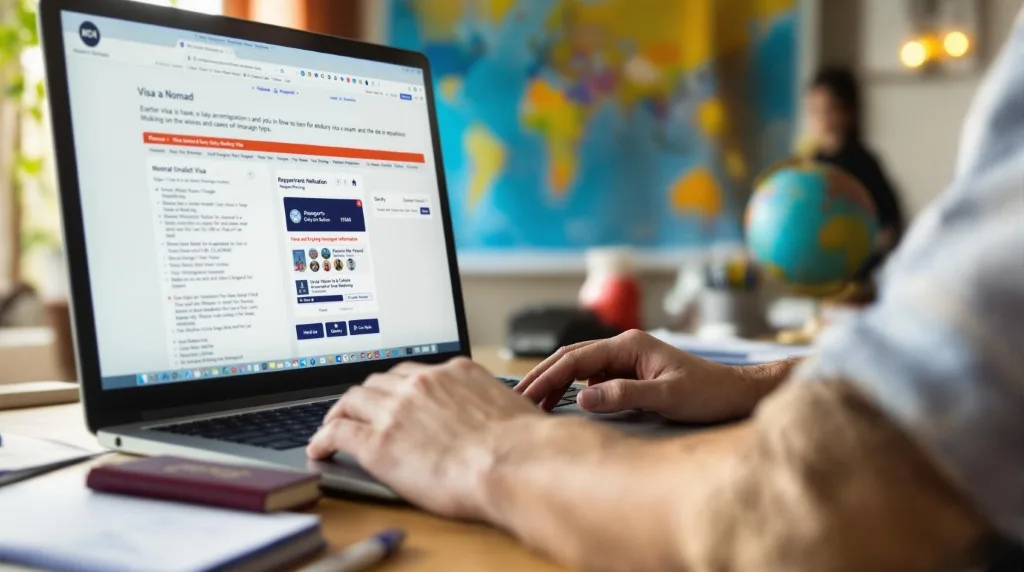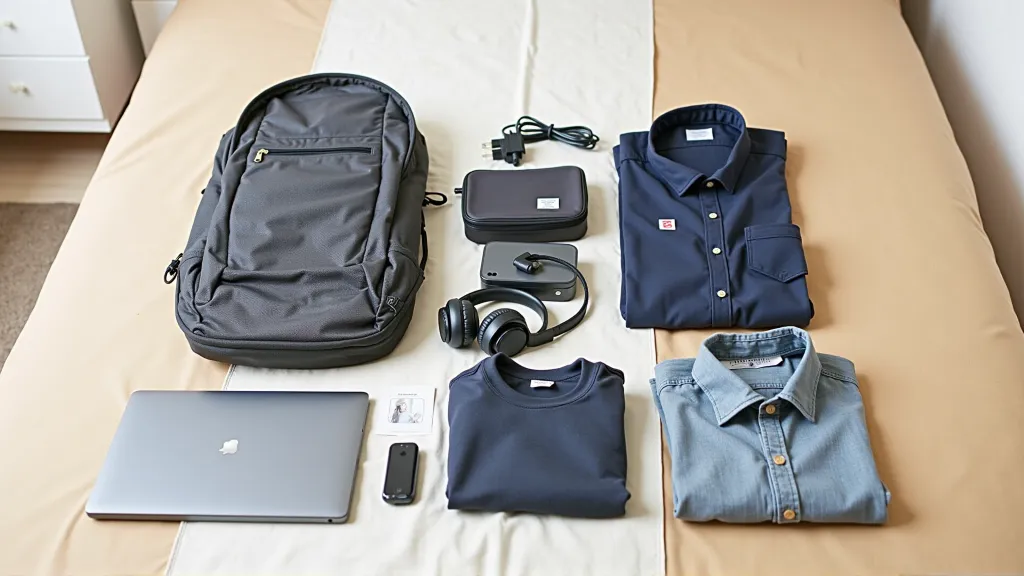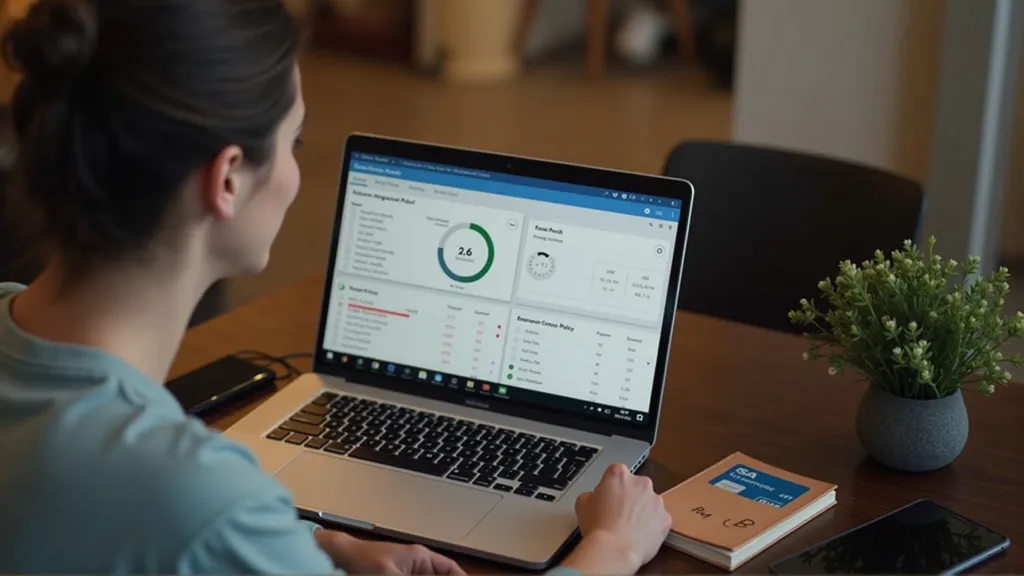The digital nomad lifestyle is more than just sipping coconuts on a beach with your laptop open—it’s about freedom, flexibility, and designing a life on your own terms. With remote work booming, more people than ever are trading office desks for coworking spaces and Airbnb stays, though it’s important to be aware of common Digital Nomad Mistakes along the way.
But here’s the real talk: while the lifestyle looks dreamy on Instagram, it comes with a unique set of challenges. From visa headaches to budget blowouts, even the most seasoned nomads hit a few bumps along the way.
In this guide, we’re breaking down 10 common digital nomad mistakes new travelers always make—and how you can avoid them from day one. These tips come from real experiences, honest lessons, and a whole lot of trial and error.
Want even more insights? Check out our Digital Nomad Tips to Simplify Life on the Road to set yourself up for success.
Digital Nomad Mistakes: Skipping Visa & Legal Research

It’s tempting to grab a one-way ticket and just go—but not checking visa rules can land you in serious trouble. Many countries don’t legally allow remote work on a tourist visa. Overstaying or working without the right permit can lead to fines, deportation, or even being banned from re-entry.
You’d be surprised how many nomads get caught off guard. One newbie arrived in Thailand thinking the 30-day stamp was enough—until they realized they needed to leave mid-project just to reset their stay. Not fun.
How to Avoid It:
- Research each country’s visa and remote work laws before booking your trip.
- Use tools like Nomad List, VisaDB, and embassy websites to stay updated.
- Look into digital nomad visas—many countries now offer them, and they’re built for your lifestyle.
- Join nomad forums or local Facebook groups to hear firsthand tips from those already on the ground.
Digital Nomad Mistakes: Underestimating the Cost of Living Abroad

“Bali is cheap!” they said. “You’ll live like royalty on $1,000 a month!”—until you realize that daily smoothie bowls, scooter rentals, coworking passes, and weekend getaways add up fast.
It’s easy to misjudge costs when everything feels affordable in the moment. But between fluctuating exchange rates, ATM withdrawal fees, and spontaneous trips, budgets vanish quicker than you’d expect. Lifestyle creep—slowly upgrading your habits—is a silent budget killer.
How to Avoid It:
- Use platforms like Numbeo, Expatistan, or the Nomad Cost of Living Calculator to get realistic numbers.
- Set a location-specific monthly budget, not a one-size-fits-all plan.
- Build in a buffer or emergency fund (think: 20–30% above your monthly goal).
- Track your expenses with apps like Trail Wallet or YNAB.
Being realistic about your spending helps you travel longer and stress less. Plan smart, and your money will go further than you think.
Not Having a Reliable Internet Plan

Nothing kills productivity faster than slow or spotty Wi-Fi—especially when you’re on a video call and suddenly freeze mid-sentence. (We’ve all been there. Cringe.)
As a digital nomad, the internet is your lifeline. Without a reliable connection, you risk missing deadlines, losing clients, or just burning hours trying to upload a simple file. Some destinations, especially remote ones, just don’t have the bandwidth for remote work demands.
How to Avoid It:
- Always test Wi-Fi speeds (use tools like Speedtest) before committing to a stay.
- Carry a global SIM card (like Airalo or GigSky) or a mobile hotspot as a backup.
- Consider coworking spaces—they usually offer stable internet, plus a great place to meet other nomads.
Ignoring Time Zone Differences

Let’s be real: nothing says “unprofessional” like missing a Zoom call because you forgot it was 3 a.m. your time. Working across time zones is a digital nomad rite of passage—but it can cause serious headaches if you don’t plan for it.
Besides confusion, poorly managed time zones can wreck your sleep schedule, mess with your focus, and even lead to burnout. One nomad I met in Medellín stayed up every night until 2 a.m. for U.S. client calls—he lasted two weeks.
How to Avoid It:
- Use tools like World Time Buddy or Calendly to sync schedules and avoid confusion.
- Block out “core work hours” that overlap with your clients or team, then protect that time.
- Consider working from time zone-friendly locations depending on where most of your work is based.
Digital Nomad Mistakes: Overpacking or Traveling with the Wrong Gear

Dragging a massive suitcase across cobblestone streets or up five flights of stairs with no elevator? Instant regret. Overpacking is a rookie mistake—and it makes every travel day harder than it needs to be.
The truth is, you don’t need five pairs of shoes or that “just in case” gear you’ll never use. What you do need is flexibility, mobility, and lightweight, durable essentials.
How to Avoid It:
- Follow a minimalist packing list tailored for digital nomads—think carry-on friendly.
- Invest in multi-functional gear, like a travel backpack with tech compartments or clothes that layer well.
- Pack for your climate, not your fantasy version of the trip. (Hint: You probably won’t go hiking every weekend.)
Digital Nomad Mistakes: No Backup Plan for Income or Emergencies

One of the riskiest digital nomad mistakes? Putting all your eggs in one basket—whether that’s one client, one job, or one bank account. Things can go sideways fast. Maybe a client suddenly drops you or your laptop crashes or Maybe you get sick in a country where healthcare isn’t cheap.
These aren’t hypothetical “what ifs”—they happen more often than you’d think. I once met a freelancer in Mexico whose only client ghosted him while he was mid-trip with no backup cash or insurance. He had to borrow money just to fly home.
How to Avoid It:
- Diversify your income. Aim to have more than one client, project, or revenue stream (freelance + passive income, for example).
- Keep an emergency fund. A stash of $500–$1,000 in USD (or a universally accepted currency) can save your butt.
- Get travel insurance. Look into plans from SafetyWing, World Nomads, or Insured Nomads that cater to remote workers.
- Pack backups. Think: a second charger, portable hard drive, and extra debit/credit card in a separate bag.
Working from Unproductive Environments

Not every Instagram-worthy café makes a great workspace. Sure, the latte art looks great, but if the Wi-Fi keeps cutting out or the music’s blasting, your focus takes a hit. Plus, most cafés aren’t thrilled if you park for six hours with one espresso.
Relying on inconsistent spots can seriously mess with your workflow—and your income.
How to Avoid It:
- Get coworking passes—they’re reliable, often fast, and filled with like-minded people.
- Choose stays with work-friendly setups. Platforms like Airbnb or Booking.com now let you filter by “dedicated workspace” or “strong Wi-Fi.”
- Have a Plan B. Save a list of backup work spots in each city in case your go-to fails you.
Comfort, quiet, and good Wi-Fi aren’t luxuries—they’re essentials.
Digital Nomad Mistakes: Failing to Maintain a Routine

One of the biggest perks of the digital nomad lifestyle? Total freedom. But total freedom without structure can quickly become chaos. Sleeping in every day, skipping workouts, and constantly chasing new experiences can leave you burned out, unproductive, or both.
A lack of routine doesn’t just impact work—it affects your mental and physical health, too. It’s all about balance.
How to Avoid It:
- Create a flexible daily routine. You don’t need to be rigid—just consistent.
- Time-block your day. Set hours for work, meals, exercise, and play.
- Use tools like Notion, Todoist, or Google Calendar to stay on track.
- Build in down days. You don’t have to be in “explorer mode” 24/7.
Not Researching Local Laws, Culture, and Etiquette

Here’s a fast way to ruin a trip: break a law you didn’t know existed. From banned websites and strict dress codes to rules around alcohol or cohabitation, each country plays by its own rules. What’s normal in Berlin might get you fined—or worse—in Bali.
A friend once shared how they were nearly denied entry into a country because they didn’t realize their remote work technically violated their tourist visa terms. And let’s not even get started on countries where kissing in public can get you in trouble.
How to Avoid It:
- Research local laws, customs, and digital policies. Is a VPN needed? Are certain sites blocked?
- Be culturally aware. Learn the basics—greetings, gestures, dress codes, and public behavior.
- Join expat or nomad groups. Local Facebook groups or forums like Nomad List often share helpful, real-time advice.
Neglecting Health & Mental Well-being

Let’s be real—traveling full-time can be exhausting. One week you’re hiking volcanoes, the next you’re trying to meet deadlines from a beach hut with zero aircon. It’s exciting… but also draining. Many new nomads burn out fast because they don’t prioritize their health—mentally or physically.
I’ve met folks who skipped routine checkups for years, or ignored creeping loneliness until it spiraled into full-on anxiety. That kind of stress doesn’t just hurt you—it can derail your whole remote lifestyle.
How to Avoid It:
- Schedule virtual health appointments. Use platforms like Zocdoc or BetterHelp for telehealth and therapy.
- Join a community. Local meetups, coworking spaces, or apps like Couchsurfing Hangouts can help you feel less isolated.
- Stick to healthy habits. Eat well, move your body, get enough sleep, and carve out downtime to recharge.
Bonus Tips for a Smoother Journey
Once you’ve dodged the big digital nomad mistakes, it’s time to level up your setup with some game-changing habits and tools.
- Use smart tools like Notion or Trello to manage your projects, Airalo for eSIMs, and Wise for fast, low-fee currency transfers.
- Stay current on entry rules, visa updates, and local SIM options. Policies change fast—especially post-COVID.
- Sharpen your soft skills. Being adaptable, culturally aware, and self-motivated makes all the difference when plans go sideways (and they will).
The smoother your systems, the more energy you’ll have for the fun parts—like beachside brainstorming or discovering the perfect hidden café with killer Wi-Fi and even better coffee.
Digital Nomad Mistakes: Embrace the Nomad Lifestyle—Wisely
Living the digital nomad dream isn’t about escaping reality—it’s about designing a better one. Avoiding these common mistakes helps you stay productive, legal, healthy, and, most importantly, happy on the road.
Take these lessons from seasoned travelers to heart so you can skip the growing pains and focus on what really matters: living freely, working smart, and exploring the world on your terms.
👉 Ready for more pro-level insights? Explore our complete Digital Nomad Tips to Simplify Life on the Road and start your journey with confidence.



